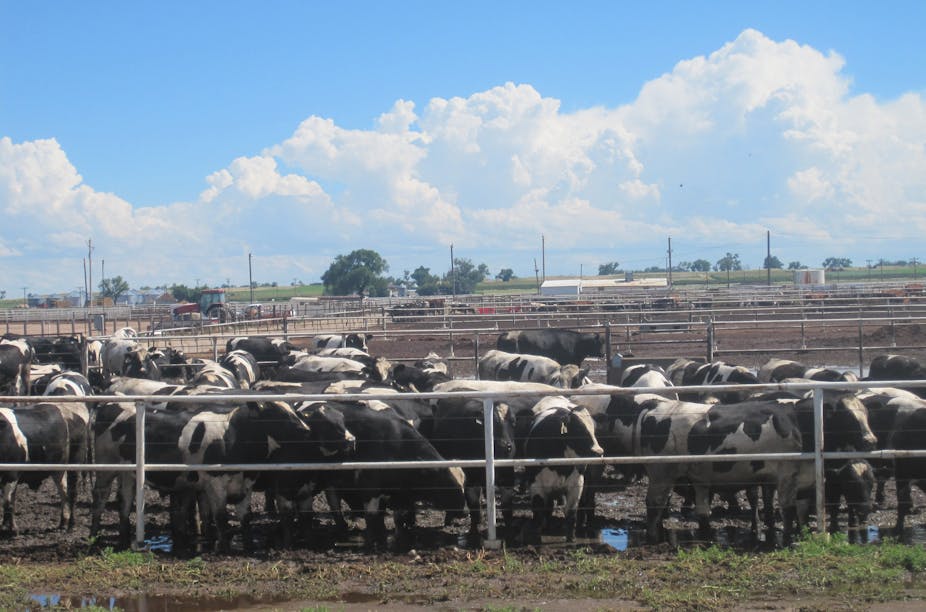The merits of eating less (or no) meat in a bid to improve environmental sustainability have been frequently debated in these pages and elsewhere.
This week saw the launch of a new book, Meat, The Future: How Cutting Meat Consumption Can Feed Billions More, which delves deep into this question, covering meat-related issues ranging from water and carbon intensity, to health and food security. One chapter, written by us, focuses on the influence of dietary choices on world phosphorus use from fertilisers, and the fate of these nutrients in the ecosphere.
It’s an issue that has already gained plenty of attention. When Al Gore released his influential 2006 movie, An Inconvenient Truth, he focused on how changing our energy systems could reduce our greenhouse gas emissions, and therefore mitigate climate change. But he was roundly criticised for ignoring another significant source of greenhouse gases: livestock and eating meat. (To his credit, Gore took this critique on board and subsequently adopted a plant-based diet.)
The same year, the United Nations Food and Agriculture Organisation released a watershed report on the environmental impacts of livestock production, finding it responsible for 18% of greenhouse gas emissions – a bigger share than transport (although its analysis was subsequently debated).
Then, in 2009, the Worldwatch Institute estimated that the production of animal-based foods (meat, dairy, eggs) across the whole production chain accounts for 51% of greenhouse emissions. The difference between the two estimates was mainly down to differing assumptions about the lifetime of methane (a potent greenhouse gas) in the atmosphere.
There can be no doubt that it is a significant and growing contributor. Half of the world’s grain is now used to produce animal feed, and animal consumption is projected to double between 2000 and 2050. The linkage between food, diet and global sustainability has not had the attention that it deserves.
Global resource use and dietary choices
Phosphorus is a unique and critical global resource, essential for growing crops (as for nitrogen) but impossible to substitute or manufacture. The world’s main source of phosphorus fertiliser is highly concentrated geo-politically (more so than oil), and with production likely to peak this century. The use of phosphorus is influenced by changing diets in a major way, with the global growth in per capita consumption being driven by the increase in the consumption of animal products.
Why do animal products have such a disproportionate impact on resource use and waste generation? The main reason is that eating animal products is a very inefficient way of getting the dietary resources we need, including and especially protein. On average, it takes three to ten times the amount of resources to produce a unit of animal protein as it does for plant-based foods. As farming becomes more industrialised, we are feeding animals with food that we could simply eat ourselves.
As it happens, in some high-income countries, people are increasingly losing their appetite for meat and other animal products such as dairy. Consumption is plateauing and declining. Certainly a contributor to this is awareness of the health implications of the high levels of meat consumption that are the norm in rich countries. Just in the past fortnight, new US government dietary guidelines have recommended a reduction in meat consumption, explicitly linking diet to environmental impact.
However, the consumption of meat and dairy products is increasing rapidly in some emerging economies (including in South America and China), although less rapidly in others (India). This is the key driver for global growth in demand for animal products, leading to increased phosphorus use, greenhouse emissions, land clearing and biodiversity loss and health impacts.
Ultimately this issue will require, at a global level, the kind of “contraction and convergence” approach that is being considered as a response to greenhouse gas emissions. Countries with high consumption of animal products will need to reduce their per capita consumption and give everyone the chance to converge on a globally sustainable level. In China alone, there are serious limits to that country’s ability to sustain the phosphorus throughput that would be required if meat consumption levels were to rise as projected.
The animal cruelty question
Meat is a complicated issue. Its consumption impacts on resource use (globally critical nutrients, water) and waste generation (agricultural run-off, greenhouse gas emissions), land use and biodiversity, food security, health, international development and animal cruelty. Regarding health impacts, non-communicable diseases are emerging as the largest cause of premature death, and in 2008 one in three adults in the world, a total of 1.46 billion, was obese or overweight, a 23% increase since 1980.
Yet it is the animal cruelty dimension that generates the most heat in this debate, despite suggestions that it should not be raised. What is undeniable is that meat-eating is inefficient, involving far more plant and cereal production to create the same amount of food and thus must be a topic of debate.
The new book does not simply chronicle the problems. There are chapters that discuss the potential for modifying dietary preferences, in the interests of people and the planet. This is a vexed issue because of cultural norms, values, habits and the power of industry lobbies and marketing. The new US nutrition report starts to provide some balance here.
But the question that the book leaves us with is clear: given that it is possible to have delicious, nutritious, satisfying food without the impact of our current over-reliance on animal products, why wouldn’t we choose that?

